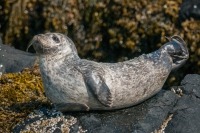
(Photo: Nick Hawkins)
Harbour Seal
Phoca vitulina
This seal has a plump body with large eyes that are close together. Nostrils form a distinctive “V” shape. It has a cat-like head with prominent, beaded, light coloured whiskers, known as vibrissae. It has no external ear flaps. The coat colour is grey to brownish grey with spots, some blotches, and ring-like markings. Coat pattern varies by location. Adult males measure up to 1.9 metres in length and weigh 70 to 150 kilograms, while females measure up to 1.7 metres in length and weigh 60 to 110 kilograms. At birth, pups measure 65 to 100 centimetres in length and weigh 8 to 12 kilograms. They have a lifespan of 20 to 30 years.
Authority
Linnaeus, 1758
Classification Details
Phylum: Chordata (chordates); Subphylum: Vertebrata (vertebrates); Class: Mammalia (mammals); Infraorder: Pinnipedia (seals, sealions, and walrus); Family: Phocidae (true seals).
Habitat
Globally distributed, with populations in North America, Europe, and Asia. There are distinct subspecies along the eastern and western coasts of the Atlantic and Pacific Oceans. Western Atlantic populations extend from the mid-Atlantic United States to the Canadian Arctic. Common in the Bay of Fundy. This is a non-migratory species; it lives in the coastal waters of the continental shelf and slope. It breeds on beaches, rocks, and ice.
Diet
Eat mainly benthic and pelagic fish. In the Bay of Fundy their diet is mainly herring, cod, pollock, and short-finned squid. Normally feed coastally, within 20 kilometres of haul-out sites. They typically dive to depths of between four and 200 metres to hunt for prey but can dive to around 500 metres. Dives are normally shorter than 10 minutes, although the longest recorded dive is 31 minutes. Need to eat around 5% of their body weight per day to maintain the thick blubber layer that keeps them warm.
Reproduction
Their mating system can range from promiscuous to polygynous. In the promiscuous system, males and females mate with many individuals. In the polygynous system, one male mates with many females. The breeding season extends from February to October, with seals mating in the water. Pups are born in the spring and summer; this occurs earlier in more southern populations. They become mature at three to seven years and gestation is about 10 months. Mothers nurse their young for four to six weeks, with milk that is 50% fat.
Fun Facts
A sub-species of harbour seal (Phoca vitulina mellonae) lives in the freshwater Lacs des Loups Marins in Quebec. The population of 500 to 600 seals was cut off from their marine relatives between 3 000 and 8 000 years ago.
References
DFO (2009) Recovery potential assessment for freshwater harbour seal, Phoca vitulina mellonae, (Lac des Loups marins Designated Unit (DU)). DFO Canadian Science Advissory Secretariat Science Advisory Report 2008/062.
Jefferson TA, Leatherwood S and Webber MA (2003) Harbour seal (Phoca vitulina) – Marine Mammals of the World. Marine Species Identification Portal. http://species-identification.org/species.php?species_group=marine_mammals&id=67 Accessed online 22 January 2020.
Krasnec MO, Cook CN and Breed MD (2012) Mating Systems in Sexual Animals. Nature Education Knowledge 3(10), 72.
NOAA. Harbour Seal – Species Directory. https://www.fisheries.noaa.gov/species/harbor-seal Accessed online 22 January 2020.
Oakley JA (2008) Phoca vitulina Common or Harbour seal. In Tyler-Walters H. and Hiscock K. (eds) Marine Life Information Network: Biology and Sensitivity Key Information Reviews, [on-line]. Plymouth: Marine Biological Association of the United Kingdom. Available from: https://www.marlin.ac.uk/species/detail/2088 Accessed online 22 January 2020.
World Register of Marine Species (2020) Phoca vitulina Linnaeus, 1758 – WoRMS Taxon Details. http://www.marinespecies.org/aphia.php?p=taxdetails&id=137084 Accessed online 22 January 2020.


